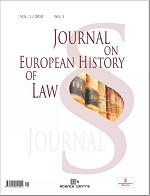Union of Brest and its Dissolution on the Territories of the Congress Kingdom of Poland, Belarusian and Lithuanian Lands
Union of Brest and its Dissolution on the Territories of the Congress Kingdom of Poland, Belarusian and Lithuanian Lands
Author(s): Przemysław DąbrowskiSubject(s): Law, Constitution, Jurisprudence
Published by: Evropská společnost pro právní dějiny, z.s.
Keywords: Union of Brest; dissolution; Congress Kingdom of Poland; Belarusian and Lithuanian Lands.
Summary/Abstract: The conditions of the union of Brest were set on a meeting in Torczyn, on 2 December 1594. Once the union was announced in Rome on 12 June 1595, a synod was convoked to Brest. Two letters were drawn – one to Sigismund III, the other to the pope Clement VIII. Cyryl Terlecki and Hipacy Pociej were appointed as plenipotentiaries to talk with the pope. In a letter to the pope they announced subscribing to the provisions of the Council of Florence of 1439, and asked for preservation of the whole liturgy and Eastern rites. In the letter addressed to the king they appealed for preservation of their old privileges and granting them the privileges enjoyed by the Catholic clergy, but also for defense in case of any interference of the Constantinople patriarchs or church sanctions. This issue was to be finally concluded at the next synod convoked in Brest. The act of union was concluded on 9 October 1596. From the times of Catherine II the Union on was doomed to be annihilated. The Orthodox Church viewed Unites as its brothers, separated from the Tsardom in the 16th century. The policy of Russian authorities was very consistent, with short breaks during the rule of Paul I, Alexander I and at the beginning of Alexander II rule.
Journal: Journal on European History of Law
- Issue Year: 2/2011
- Issue No: 2
- Page Range: 86-90
- Page Count: 5
- Language: English

